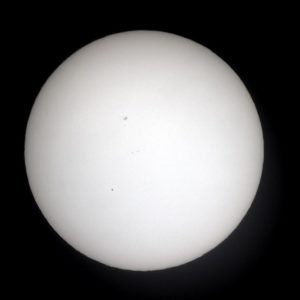On May 9th Mercury made a transit across the Sun, meaning it passed between the Sun and the Earth. This only happens about 13 times a century, with the next transit on November 11th, 2019. Typically this takes several hours and we were fortunate to have clear skies for the first few hours.
Mercury is the smallest planet in our solar system with a radius of about 1,500 miles and is about 36 million miles from the Sun. For comparison, the Earth has a radius of about 4,000 miles and is 93 million miles from the Sun. The radius of the Sun is 432,000 miles.
I used my 6″ f/8 dobsonian telescope with a very special type of solar filter in front of the telescope that blocks 99.999% of the Sun’s light. Even with the solar filter in place it still seemed fairly bright to look at.
This first picture was captured simply by holding an iPhone up to the eyepiece on my telescope and snapping a picture. You can see Mercury which appears as a small circle located down and to the left of the center of the sun. You can also see some a few different sunspots up near the center and also up and to the left a little.
Here’s another photo, this one taken with my camera and a 2.5x barlow lens. This one shows how big the sun really is compared to Mercury.
I find the Sun to be fascinating to view through the telescope, both how it appears as almost a perfect sphere just floating in space and also seeing the sunspots that are regularly moving across its face. It’s interesting to think about this massive ball of plasma with fusion of hydrogen atoms happening in it’s core, starting about 4.6 billion years ago, and has enough to continue for another 5 billion years.
The Earth is about 8 1/2 light minutes (93 million miles) from the Sun which means it takes light that long to travel from the Sun to Earth. More interesting is that before those photons of light start their journey to the Earth, it takes somewhere between 10,000 to over 100,000 years for them to travel from the core to the surface of the sun.
NEVER LOOK AT THE SUN THROUGH BINOCULARS OR A TELESCOPE WITHOUT PROPER FILTERS AND EXTREME CAUTION – IT WILL CAUSE IMMEDIATE AND PERMANENT BLINDNESS.

